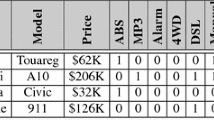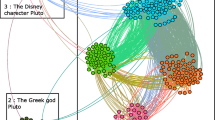Abstract
In this paper, we are interested in taking preferences into account for a family of queries inspired by the relational division. A division query aims at retrieving the elements associated with a specified set of values and usually the results remain not discriminated. So, we suggest the introduction of preferences inside such queries with the following specificities: (i) the user gives his/her preferences in an ordinal way and (ii) the preferences apply to the divisor which is defined as a hierarchy of sets. Different uses of the hierarchy are investigated, which leads to queries conveying different semantics and the property of the result in terms of a quotient is studied. Special attention is paid to the implementation of such extended division queries using a regular database management system along which some experiments to support the feasibility of the approach. Moreover, the issue of empty or overabundant answers is dealt with.
Similar content being viewed by others
References
Bőrzsőnyi, S., Kossmann, D., & Stocker, K. (2001). The skyline operator. In Proc. of the 17th IEEE inter. conf. on data engineering (pp. 421–430).
Bosc, P., & Pivert, O. (2008). On a parameterized antidivision operator for database fLexible querying. In Proc. of the 19th conference on database and expert systems applications (pp. 652–659).
Bosc, P., Pivert, O., & Rocacher, D. (2007). About quotient and division of crisp and fuzzy relations. Journal of Intelligent Information Systems, 29(2), 185–210.
Bruno, N., Chaudhuri, S., & Gravano, L. (2002). Top-k selection queries over relational databases: Mapping strategies and performance evaluation. ACM Transactions on Database Systems, 27(2), 153–187.
Chomicki, J. (2003). Preference formulas in relational queries. ACM Transactions on Database Systems, 28(4), 427–466.
Dubois, D., & Prade, H. (1996). Using fuzzy sets in fLexible querying: Why and how. In Proc. of the workshop on flexible query-answering systems (FQAS’96) (pp. 89–103).
Dubois, D., & Prade, H. (2008). Handling bipolar queries in fuzzy information processing. In Handbook of research on fuzzy information processing in databases (pp. 97–114). IGI Global Publication.
Fodor, J., & Yager, R. (1999). Fuzzy-set theoretic operators and quantifiers. In The handbook of fuzzy sets series (pp. 125–193). Norwell: Kluwer.
Hadjali, A., Kaci, S., & Prade, H. (2008). Database preference queries—A possibilistic logic approach with symbolic priorities. In Proc. of the 5th symposium on the foundations of information and knowledge systems (FoIKS’08) (pp. 291–310).
Kerre, E., & Liu, Y. (1998). An overview of fuzzy quantifiers—Interpretations. Fuzzy Sets and Systems, 95, 1–22.
Kießling, W., & Köstler, G. (2002). Preference SQL—Design, implementation, experiences. In Proc. of the 28th conference on very large data bases (VLDB’02) (pp. 990–1001).
Lacroix, M., & Lavency, P. (1987). Preferences: Putting more knowledge into queries. In Proc. of the 13th conference on very large data bases (VLDB’87) (pp. 217–225).
Zadeh, L. (1983). A computational approach to fuzzy quantifiers in natural languages. Computer Mathematics with Applications, 9, 149–183.
Author information
Authors and Affiliations
Corresponding author
Rights and permissions
About this article
Cite this article
Bosc, P., Pivert, O. & Soufflet, O. On three classes of division queries involving ordinal preferences. J Intell Inf Syst 37, 315–331 (2011). https://doi.org/10.1007/s10844-010-0147-y
Received:
Revised:
Accepted:
Published:
Issue Date:
DOI: https://doi.org/10.1007/s10844-010-0147-y




